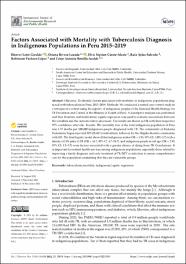“Factors Associated with Mortality with Tuberculosis Diagnosis in Indigenous Populations in Peru 2015–2019“

View/
Download
(application/pdf: 985.0Kb)
(application/pdf: 985.0Kb)
Date
2022Author(s)
León-Giraldo, Hoover
Rivera-Lozada, Oriana
Castro-Alzate, Elvis Siprian
Aylas-Salcedo, Rula
Pacheco-López, Robinson
Bonilla-Asalde, César Antonio
Metadata
Show full item recordAbstract
“Objective: To identify factors associated with mortality in indigenous populations diagnosed with tuberculosis in Peru, 2015–2019. Methods: We conducted a nested case-control study in
a retrospective cohort using the registry of indigenous peoples of the National Health Strategy for
TB Prevention and Control of the Ministry of Health of Peru. A descriptive analysis was performed,
and then bivariate and multivariate logistic regression was used to evaluate associations between
the variables and the outcome (alive–deceased). The results are shown as OR with their respective
95% confidence intervals. Results: The mortality rate of the total indigenous population of Peru
was 1.75 deaths per 100,000 indigenous people diagnosed with TB. The community of Kukama
Kukamiria-Yagua reported 505 (28.48%) individuals, followed by the Shipibo-Konibo community
with 385. The final logistic model showed that indigenous males (OR = 1.93; 95% CI: 1.001–3.7) with a
history of HIV prior to TB (OR = 16.7; 95% CI: 4.7–58.7), and indigenous people in old age (OR = 2.95;
95% CI: 1.5–5.7) were factors associated with a greater chance of dying from TB. Conclusions: It
is important to reorient health services among indigenous populations, especially those related to
improving a timely diagnosis and early treatment of TB/HIV co-infection, to ensure comprehensive
care for this population considering that they are vulnerable groups“
Collections
- SCOPUS [380]

